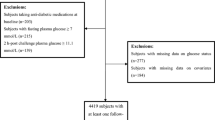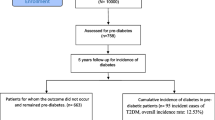Abstract
The association between atherogenic dyslipidemia (AD) and incident type 2 diabetes (T2D) in the low-risk group for T2D has not yet been determined. The aims of this study were to investigate whether AD, characterized by increased serum apoB and non-HDL cholesterol, could predict the development of T2D in subjects with normal glucose tolerance (NGT). A total of 84,394 subjects with NGT (48,906 men and 35,488 women), aged 20–89 years (mean age 38.4 years), were enrolled in this study and were followed for a mean duration of 3.3 years. ApoB and non-HDL cholesterol levels showed stronger associations with the development of T2D compared with conventional lipid measurements and their ratios (HR per 1-SD (95 % CI) 1.27 (1.23–1.30) and 1.27 (1.24–1.29), respectively, both P < 0.001). In multivariate Cox regression models, both apoB and non-HDL cholesterol were associated with the development of T2D, independent of other risk factors for T2D, fasting serum glucose, HbA1c, and conventional lipid measurements such as triglycerides and HDL cholesterol (HR per 1-SD (95 % CI) 1.16 (1.11–1.21) and 1.15 (1.11–1.19), respectively, both P < 0.001). However, fasting serum glucose was not associated with the development of T2D in these models. In conclusion, AD was more closely associated with the development of T2D than fasting glucose or glycated hemoglobin in subjects with NGT.
Similar content being viewed by others
References
Adiels M, Olofsson SO, Taskinen MR, Borén J (2008) Overproduction of very low-density lipoproteins is the hallmark of the dyslipidemia in the metabolic syndrome. Arterioscler Thromb Vasc Biol 28:1225–1236
Bamba V, Rader DJ (2007) Obesity and atherogenic dyslipidemia. Gastroenterology 132:2181–2190
Barter PJ (2011) The causes and consequences of low levels of high-density lipoproteins in patients with diabetes. Diabetes Metab J 35:101–106
Sniderman AD, Furberg CD, Keech A et al (2003) Apolipoproteins versus lipids as indices of coronary risk and as targets for statin treatment. Lancet 361:777–780
Kastelein JJ, van der Steeg WA, Holme I et al (2008) Lipids, apolipoproteins, and their ratios in relation to cardiovascular events with statin treatment. Circulation 117:3002–3009
Walldius G, Jungner I, Holme I, Aastveit AH, Kolar W, Steiner E (2001) High apolipoprotein B, low apolipoprotein A-I and improvement in the prediction of fatal myocardial infarction (AMORIS study): a prospective study. Lancet 358:2026–2033
Thompson A, Danesh J (2006) Associations between apolipoprotein B, apolipoprotein AI, the apolipoprotein B/AI ratio and coronary heart disease: a literature-based meta-analysis of prospective studies. J Intern Med 259:481–492
Ley SH, Harris SB, Connelly PW et al (2010) Association of apolipoprotein B with incident type 2 diabetes in an aboriginal Canadian population. Clin Chem 56:666–670
Salomaa V, Havulinna A, Saarela O et al (2010) Thirty-one novel biomarkers as predictors for clinically incident diabetes. PLoS ONE 5:e10100
Hwang YC, Ahn HY, Yu SH, Park SW, Park CY (2014) Atherogenic dyslipidaemic profiles associated with the development of Type 2 diabetes: a 3.1-year longitudinal study. Diabet Med 31:24–30
Expert Panel on Detection, Evaluation, and Treatment of High Blood Cholesterol in Adults (2001) Executive summary of the third report of the national cholesterol education program (NCEP) Expert panel on detection, evaluation, and treatment of high blood cholesterol in adults (Adult Treatment Panel III). JAMA 285:2486–2497
American Diabetes Association (2010) Diagnosis and classification of diabetes mellitus. Diabetes Care 33:S62–S69
Matthews DR, Hosker JP, Rudenski AS, Naylor BA, Treacher DF, Turner RC (1985) Homeostasis model assessment: insulin resistance and beta-cell function from fasting plasma glucose and insulin concentrations in man. Diabetologia 28:412–419
Binnert C, Genoud M, Seematter G et al (2005) Glucose-induced insulin secretion in dyslipidemic and normolipidemic patients with normal glucose tolerance. Diabetes Care 28:1225–1227
Laakso M, Sarlund H, Mykkänen L (1990) Insulin resistance is associated with lipid and lipoprotein abnormalities in subjects with varying degrees of glucose tolerance. Arteriosclerosis 10:223–231
Chahil TJ, Ginsberg HN (2006) Diabetic dyslipidemia. Endocrinol Metab Clin North Am 35:491–510
Samuel VT, Petersen KF, Shulman GI (2010) Lipid-induced insulin resistance: unravelling the mechanism. Lancet 375:2267–2277
Meigs JB, Nathan DM, Wilson PW, Cupples LA, Singer DE (1998) Metabolic risk factors worsen continuously across the spectrum of nondiabetic glucose tolerance. The Framingham Offspring Study. Ann Intern Med 128:524–533
Preiss D, Seshasai SR, Welsh P et al (2011) Risk of incident diabetes with intensive-dose compared with moderate-dose statin therapy: a meta-analysis. JAMA 305:2556–2564
Conflict of interest
The authors declare that they have no conflict of interest.
Statement of Human and Animal Rights
All procedures followed were in accordance with the ethical standards of the responsible committee on human experimentation (institutional and national) and with the Declaration of Helsinki 1975, as revised in 2008.
Author information
Authors and Affiliations
Corresponding author
Additional information
Managed by Massimo Porta.
Rights and permissions
About this article
Cite this article
Hwang, YC., Ahn, HY., Park, SW. et al. Apolipoprotein B and non-HDL cholesterol are more powerful predictors for incident type 2 diabetes than fasting glucose or glycated hemoglobin in subjects with normal glucose tolerance: a 3.3-year retrospective longitudinal study. Acta Diabetol 51, 941–946 (2014). https://doi.org/10.1007/s00592-014-0587-x
Received:
Accepted:
Published:
Issue Date:
DOI: https://doi.org/10.1007/s00592-014-0587-x




